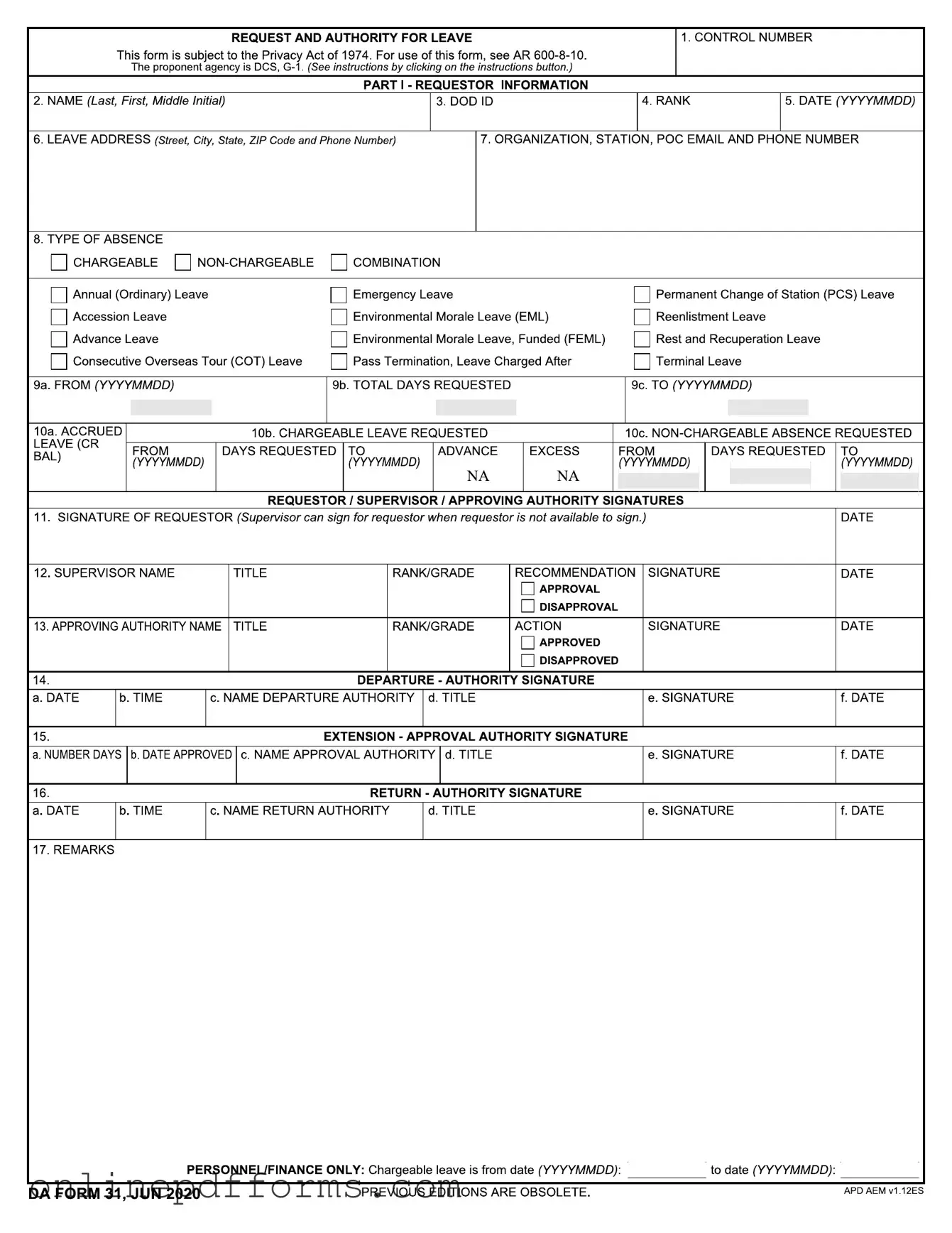The DA 31 form, which serves as a request and authority for leave, shares similarities with the Standard Form 50 (SF-50). The SF-50 is used by federal agencies to document personnel actions, such as appointments, promotions, and separations. Both forms require detailed information about the individual, including their name, identification number, and the dates relevant to the requested action. While the DA 31 focuses on leave requests, the SF-50 captures broader employment changes, making them both essential for managing employee records within the federal workforce.
Another document akin to the DA 31 is the Request for Leave or Approved Absence (Form 1150). This form is utilized by federal employees to formally request leave from their supervisors. Like the DA 31, it necessitates information on the type of leave, duration, and the employee's contact details. Both forms require supervisory approval, ensuring that the leave process is managed consistently and transparently across agencies.
The Leave and Earnings Statement (LES) also bears resemblance to the DA 31 in that it provides vital information about an employee's leave balance. The LES details accrued leave, which is crucial for understanding how much leave an employee can request on the DA 31. While the LES is primarily a financial document, it complements the DA 31 by offering a snapshot of an employee's leave status, thereby informing their leave requests.
The Family and Medical Leave Act (FMLA) Request form is another document that parallels the DA 31. This form allows employees to request leave for family or medical reasons under the FMLA. Both forms require specific information about the type of leave being requested and the duration. The DA 31 focuses on various leave types, while the FMLA Request form is specifically geared toward protecting employees’ rights during medical or family emergencies.
The Application for Leave Without Pay (LWOP) form is similar to the DA 31 as it allows employees to request an unpaid leave of absence. Both documents require the employee to provide a rationale for their absence and seek supervisory approval. The DA 31 captures chargeable and non-chargeable leave, while the LWOP form specifically addresses situations where an employee seeks to take leave without pay, highlighting different aspects of leave management.
The Absence Request form used in some organizations also shares commonalities with the DA 31. This form is utilized to request time off for various reasons, including personal leave, sick leave, or vacation. Similar to the DA 31, it requires the employee to specify the type of absence and the dates requested. Both forms aim to streamline the leave request process, ensuring that supervisors have the necessary information to make informed decisions.
The Employee Leave Request form from the Department of Veterans Affairs (VA) is another document that resembles the DA 31. This form allows VA employees to formally request leave and includes sections for detailing the type of leave and duration. Both forms emphasize the importance of obtaining approval from supervisors, ensuring that leave is managed in a way that does not disrupt operations.
The Military Leave Request form is also similar to the DA 31. This form is used by military personnel to request leave for various reasons, including training or personal matters. Both documents require detailed information about the service member, the type of leave requested, and the dates involved. The military leave request process mirrors that of the DA 31, emphasizing the need for clear communication and proper authorization.
Lastly, the Leave Request Form used by private sector employers can be compared to the DA 31. This form allows employees to request time off for personal, sick, or vacation leave. Both forms require the employee to indicate the type of leave and the dates requested. They serve to standardize the leave process, ensuring that all requests are documented and approved in a consistent manner.
